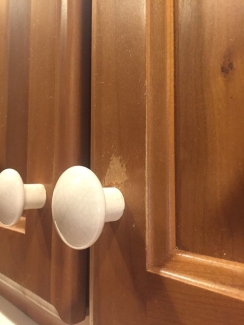

There are several reasons to choose Dye Stain. Here are a few.
Water-based Dye Stains penetrate deep into the wood to beautifully magnify the grain. This low VOC stain will provide your project with more depth and color vibrancy than any other wood stain.
Yes, one of its uses is to dilute dye stain colors. Dye Stain reducer is the clear base the we use when manufacturing our dye stains. We make the reducer first, then add the dye color.
It is easy to make your own custom color Dye Stain by adding in 10% increments until you achieve the color you want. It is not possible to mix too much of our dye stain or reducer together.
Additionally, General Finishes Water Based Stains can be mixed into the reducer, which will lighten the color and thin the viscosity so it will penetrate deeper into the wood.
Yes, there are a couple of ways. Dye Stain Reducer is the clear base that we use when manufacturing General Finishes Dye Stains. The Reducer is made first, then the dye color is added.
It is easy to make your own custom color Dye Stain by adding in 10% increments of Dye Stain color to Reducer until you achieve the color you want. It is not possible to mix too much of our Dye Stain and Reducer together.
Dye Stain Reducer is the clear base we use when manufacturing General Finishes Dye Stain and can be used to make custom Dye Stain colors and for toning.
First, test your surface to get a sense for the color present in the wood. To do this, wipe the surface down with mineral spirits (if you are expecting to use an oil finish) or plain water (if you are expecting to use a water based finish). See the following GF video demonstration for a better understanding of this process.
Next, apply product. Here are two recipes for a lightly stained look:

General Finishes does not think light scratches on a door are so significant that it would be necessary for you to strip down the finish.
Instead of stripping, GF recommends that you try:
It is normal to see a bit of stain on the brush when applying the first coat of topcoat. Topcoats often pull a bit of color on the first pass, but good preparation will minimize this.
To prepare open grains woods such as raw Oak for a water-based stain, we recommend sanding with 180-grit followed by no more than 220-grit sandpaper.
Keep that bronze, sun-kissed look all year with Bronze Pearl Effects!
General Finishes Water Based Stains have superior qualities over oil-based stains. Their high-quality pigments produce rich, dark, uniform colors on hard-to-stain woods like maple and pine.